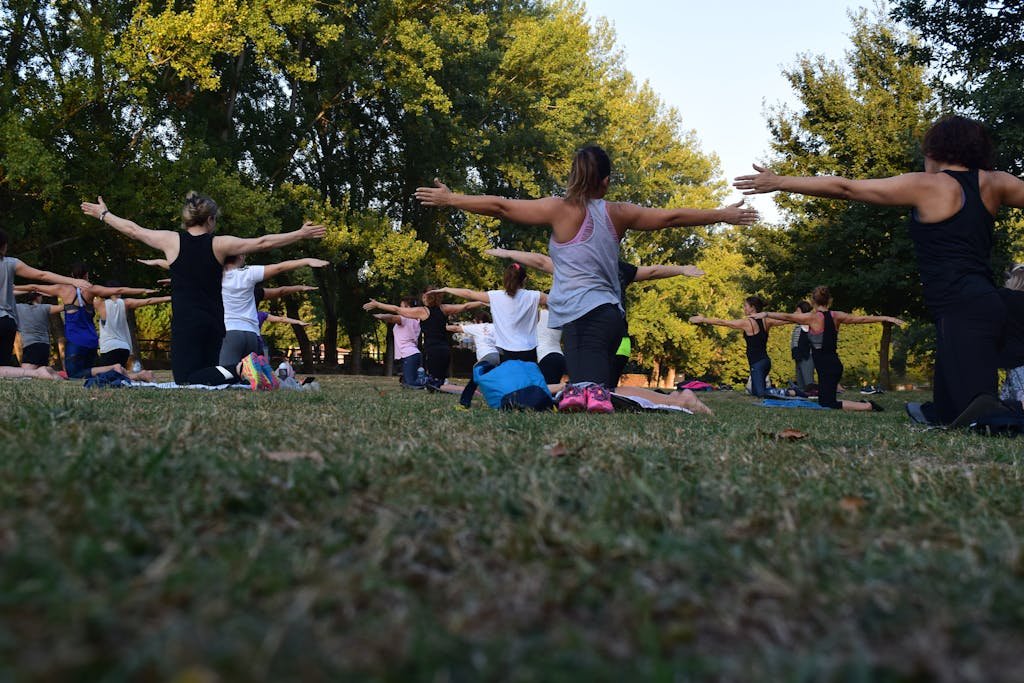What if the habits you think help your fitness are actually holding you back?
This guide will show you nine common workout mistakes. It will also give you clear, evidence-based strategies. These will help you optimize workouts, prevent injury, and get the most physical activity benefits for your body and mind.
You’re the audience: beginners getting back into exercise, busy professionals across the United States, and anyone who wants better results and improved mental health from their routine. You’ll find practical, second-person advice you can apply this week.
We’ll start by explaining why physical activity matters. Then, we’ll walk through specific errors like skipping warm-ups, repeating the same workout, and neglecting strength training. We’ll cover poor nutrition, hydration, overtraining, and other pitfalls, with fixes that help you recover faster and reduce stress.
This is a long-form, actionable piece with sample routines, timelines, and evidence-backed tips. It will help you optimize workouts, avoid exercise mistakes, and enjoy lasting physical activity benefits.
Physical Activity: Why It Matters for Your Body and Mind
Regular physical activity shapes your body and mood in clear ways. Small, consistent steps improve heart health and support a healthy weight. They also strengthen bones and muscles, and boost balance and mobility.
You don’t need extreme workouts to see gains. Steady habits over weeks and months produce lasting change.
Overview of physical activity benefits
When you move regularly, your blood pressure and cholesterol often improve. Your body becomes more sensitive to insulin. This lowers long-term risk for heart disease and type 2 diabetes.
Stronger muscles and denser bones make daily tasks easier. They also reduce fall risk as you age. Improved mobility and balance help you stay independent and active.
How exercise and mental health are connected
Evidence shows a clear link between exercise and mental health. Aerobic activities and resistance training help reduce anxiety and depressive symptoms. They increase endorphins and BDNF, supporting clearer thinking and mood.
Key physical fitness and mental health outcomes to expect
You can expect mood lifts within a few weeks and better sleep quality soon after starting. Over months, steady activity often brings gradual reductions in depressive symptoms. It also increases strength and endurance.
Stress regulation improves as the HPA axis becomes better balanced. This helps you cope with daily pressures.
Practical choices matter. The best physical activities for mental wellness include brisk walking, cycling, swimming, yoga, and structured resistance training. Aim for at least 150 minutes of moderate aerobic activity each week plus muscle-strengthening two or more days for full benefit.
Consistency beats occasional intensity. Small, sustainable changes build cumulative benefits for both physical fitness and mental health. This approach maximizes the physical activity benefits for depression and builds resilience you can keep for years.
| Activity | Why it helps | Frequency & Intensity |
|---|---|---|
| Brisk walking | Boosts cardiovascular health, improves mood, easy on joints | 30 min, 5 days/week at moderate pace |
| Cycling | Builds endurance, lowers stress, indoor and outdoor options | 40 min, 3–5 days/week at moderate intensity |
| Swimming | Full-body conditioning, low impact, calms breathing | 30–45 min, 2–4 days/week, moderate effort |
| Yoga | Improves flexibility, reduces anxiety, aids sleep | 20–60 min, 2–5 days/week, mix of restorative and flow |
| Resistance training | Builds muscle, improves metabolism, supports mood | 20–60 min, 2 or more days/week, progressive loads |
Common Mistake: Skipping a Proper Warm-Up and Cool-Down
Skipping prep or finish routines can harm your progress and increase injury risk. Warm-ups prepare muscles, raise body temperature, and improve coordination. This makes your first set safer and more effective.
Cool-down stretches remove metabolic waste, lower heart rate, and prevent dizziness after exercise.
Why warming up and cooling down matter for injury prevention
Warming up increases muscle temperature and joint flexibility. This reduces the risk of strains and sprains during hard efforts. It also enhances neuromuscular activation, ensuring muscles work correctly when lifting or changing direction.
Cooling down helps recovery by moving blood through muscles and removing waste. Without it, you face higher injury risk, worse muscle soreness, poorer performance, and longer recovery times.
Simple dynamic warm-up routines you can do in minutes
Quick dynamic warm-ups get you ready without taking much time. Try a 3–8 minute sequence: start with brisk marching or jogging for a minute. Then do leg swings, arm circles, hip openers, inchworms, bodyweight squats, and band pull-aparts.
For sports training, use specific movements. Runners should do dynamic lunges and high knees. Basketball players should add lateral shuffles and reactive steps. If time is tight, build warm-up sets into your first working sets.
Effective cool-down stretches to aid recovery and reduce soreness
Spend 5–10 minutes lowering intensity after your workout. Start with light walking or easy cycling to drop your heart rate. Then do static stretches for hamstrings, quads, calves, glutes, chest, and shoulders for 20–30 seconds each.
Use foam rolling for tight spots and practice diaphragmatic breathing to calm your nervous system. For a quick cool-down, use a single stretch and focused breathing for 2–3 minutes.
Older adults and those with heart conditions should increase intensity slowly and get medical clearance before vigorous exercise. These simple steps improve safety, support consistent Physical Activity, and show how exercise reduces stress through better recovery and stable performance.
Common Mistake: Doing the Same Workout Every Time
Doing the same workout every week can slow down your progress. It can also hurt your joints, tendons, and muscles. You might get bored, lose motivation, and stop seeing improvements.
This routine can lead to overuse injuries. It also makes Physical Activity less fun.
Risks of plateaus and overuse injuries
When your body gets used to the same routine, you won’t see the same results. Your performance might slow down, and small pains could become big problems. Injuries often happen in the knees, shoulders, and lower back after doing the same thing for months.
How to add variety: cross-training and progressive overload
Cross-training means changing up your activities. Try running, cycling, swimming, strength training, and yoga. This spreads out the stress and builds different fitness skills.
Progressive overload means adding a little more challenge each time. You can do this by lifting heavier weights, doing more reps, or changing how fast you do exercises. Keep track of your progress to catch any slowdowns early.
Sample weekly rotation for balanced fitness
Here’s a plan that mixes things up while keeping a routine. It’s good for your mind and body. Trying new things can make exercise more enjoyable and keep you motivated.
| Day | Focus | Duration | Why it helps |
|---|---|---|---|
| Monday | Strength (full-body) | 45 min | Builds muscle, raises metabolism, supports daily function |
| Tuesday | Moderate cardio (brisk walk or cycling) | 30–40 min | Improves endurance, aids recovery, gentle on joints |
| Wednesday | Mobility / yoga + light core | 30 min | Enhances flexibility, reduces injury risk, supports mental calm |
| Thursday | Interval cardio (HIIT or hill sprints) | 20–30 min | Boosts cardiovascular fitness and efficiency in less time |
| Friday | Strength (different movement patterns) | 40–45 min | Targets weaknesses, balances muscle development |
| Saturday | Active recovery (hike, swim, recreational sport) | 30–60 min | Promotes blood flow, keeps activity enjoyable |
| Sunday | Rest or gentle stretching | 15–30 min | Allows recovery and mental reset |
Start with this plan or adjust it if you’re new or busy. You can break sessions into shorter blocks. Mix up your activities each week and aim for small, steady increases in your workouts.
Keep track of how you feel and celebrate small victories. Cross-training keeps your workouts interesting and helps prevent injuries. It’s also great for your mood and mental health, making it a long-term habit.
Common Mistake: Neglecting Strength Training
Many people focus only on cardio and miss the wide-ranging advantages of strength work. Strength training benefits include a higher resting metabolic rate, better glucose regulation, stronger bones, and improved balance. These changes support daily function as you age and lower fall risk.
Benefits of strength work for metabolism and mental wellness
Adding resistance sessions helps build lean mass that burns more calories at rest. This aids in weight control and metabolic health. Strength for mental wellness is backed by professional groups like the American College of Sports Medicine.
Resistance work raises BDNF and endorphins, improves sleep quality, and increases confidence. These shifts contribute to long-term physical fitness and mental health by strengthening coping skills and self-efficacy.
Easy strength routines for beginners and busy schedules
You can get results with two full-body sessions per week. Focus on compound moves like squats, push-ups, bent-over rows, kettlebell deadlifts, and planks. Aim for 3 sets of 8–12 reps across 4–6 exercises.
Allow 20–40 minutes per session. Use progressive overload by increasing load or reps every 2–4 weeks. At home, substitute resistance bands, progress bodyweight patterns, or use household items like filled water jugs as weights.
How strength training helps with physical activity benefits for depression
Strength training supports the physical activity benefits for depression through several pathways. Better sleep and regular movement improve mood regulation. Group or partner sessions increase social engagement and accountability.
Neurochemical responses from resistance training can reduce anxiety and lift mood. Your body image and confidence often improve with consistent strength gains. These psychological shifts reinforce continued Physical Activity and deepen the connection between physical fitness and mental health.
Start with manageable loads and prioritize clean technique. Consider a few sessions with a certified trainer from organizations such as the American Council on Exercise to learn safe movement patterns. This approach lowers injury risk and helps you stick with a program that delivers both metabolic and mental benefits.
Common Mistake: Ignoring Proper Nutrition and Hydration
Good fueling and fluid habits are key for safe, effective Physical Activity. Carbohydrates power short, high-intensity efforts. Protein repairs and builds muscle, and fats supply steady energy for longer sessions. Total calorie balance shapes performance and post-session recovery.
Fueling your workouts: pre- and post-exercise nutrition tips
For light to moderate workouts, eat a small carbohydrate-rich snack 30–90 minutes before you start. Choose a banana, toast with peanut butter, or yogurt to support energy without upsetting your stomach. For intense or long sessions, plan a mixed meal 2–3 hours beforehand that includes carbohydrates, lean protein, and a little healthy fat.
After exercise, aim for 20–40 grams of protein within 1–2 hours to support muscle protein synthesis. A whey or plant-based shake, Greek yogurt, or lean turkey are practical options. Add carbohydrates after long or glycogen-depleting sessions to aid post-workout recovery and restore fuel stores.
Hydration strategies for different types of activity
Maintain baseline hydration every day; pale yellow urine is a simple check. Drink 8–12 ounces 15–30 minutes before starting exercise. During moderate efforts sip 4–8 ounces every 15–20 minutes based on your sweat rate and the environment. For prolonged or hot-weather sessions, include an electrolyte beverage to replace sodium and other minerals lost in sweat.
Afterwards rehydrate with water or a sports drink for heavy sweating. Adjust volume upward in heat and for longer workouts. Older adults should pay special attention to regular sipping, since thirst sensation can be blunted with age.
Supplements and when they might be useful
Most nutrients come from food. Evidence-based supplements can fill specific gaps. Creatine monohydrate supports strength and power gains for many athletes. Whey protein offers a convenient way to hit post-workout protein targets. Vitamin D is helpful when levels are low, especially for people with limited sun exposure.
Be cautious with stimulant-heavy pre-workout products that contain high doses of caffeine or proprietary blends. Talk with a healthcare provider or registered dietitian before starting new supplements, particularly if you take medication or have health conditions. Athletes with targeted goals may benefit from a periodized fueling plan and older adults may need more protein per meal to trigger muscle synthesis.
Common Mistake: Overtraining and Not Prioritizing Recovery
Pushing too hard can hurt your progress if you ignore your body’s need for rest. Overtraining is different from pushing yourself a bit harder to get better. Signs of overtraining include constant tiredness, muscle soreness that lasts, and a higher resting heart rate.
Recovery is key in any training plan. Aim for 7–9 hours of sleep each night. Try to keep a regular sleep schedule and avoid screens before bed. Eating enough calories and protein helps your body repair itself.
Active recovery helps your body without adding stress. Try light activities like walking or swimming on your off-days. Mobility exercises improve how you move and help your tissues stay healthy.
Simple routines can help with rest. Try a 10–20 minute wind-down before bed to relax. Add a 15–30 minute mobility session on off-days to loosen up and aid in repair.
Rest is also good for your mind. It lowers stress hormones and improves your mood. Remember, you get stronger when you rest, not just when you train.
Be careful not to fall into traps. Avoid using sleep aids without a doctor’s advice. Don’t ignore symptoms that don’t go away. Recovery is personal, so listen to your body.
| Issue | Signs | Simple Daily Action |
|---|---|---|
| Overtraining | Persistent fatigue, decreased performance, frequent illness | Take one full rest day and track sleep and mood |
| Poor sleep | Insomnia, daytime tiredness, slower recovery | Follow sleep hygiene: consistent schedule, no screens 60 minutes before bed |
| Insufficient mobility | Stiff joints, limited range, recurring aches | 15–30 minute mobility flow focusing on hips and thoracic spine |
| Low fueling | Slow repair, poor strength gains, loss of weight when not desired | Ensure adequate calories and 20–30 g protein after workouts |
| Ignoring stress | Elevated cortisol, irritability, reduced motivation | Short breathing breaks, light active recovery, and scheduled deload weeks |
Conclusion
This article showed why Physical Activity is key for both body and mind. It also pointed out nine common mistakes that can hold you back. You learned how a good warm-up and cool-down prevent injuries and why doing the same workout over and over can stop progress.
It also stressed the importance of strength training, nutrition, hydration, and recovery for better performance. Each section gave you simple, practical tips to improve your workouts and keep your health safe.
Start with a small change this week. Try adding a five-minute dynamic warm-up, doing two short strength sessions, or tracking your water intake. Aim for 150 minutes of moderate aerobic activity and strength training twice a week. These steps help you avoid mistakes and improve your physical fitness and mental health.
Regular exercise boosts your mood, improves sleep, and shows the link between exercise and mental health. You’ll see less depression and better stress handling as you get better. Make your plan personal, listen to your body, and get advice from a doctor or trainer when needed.
Use these tips to avoid common mistakes, protect your body, and lift your mood. Make small, lasting changes to get the most from exercise. Discover how physical activity reduces stress and supports lasting well-being.
FAQ
What are the nine most common mistakes people make with physical activity?
Skipping warm-ups and cool-downs is a big mistake. Doing the same workout every time can also lead to boredom. Not focusing on strength training and ignoring nutrition and hydration are other errors.






